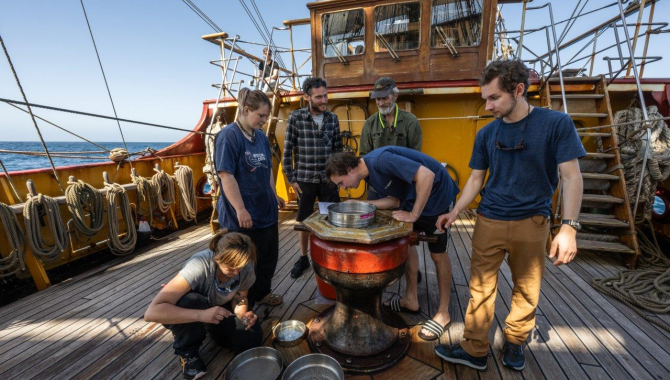Studding sails and Manta trawls

Strong Southeasterlies are backing today to Light Southerlies while the seas calm down too close to the African coast.
And then, it happened. After days and days in a row, sailing close-hauled in windy conditions and steep seas, late last night the Southeasterlies started backing to a light Southerly, the swell and waves abated.
Walvis Bay lies north of us, it is time for the night watches to brace square and finish the preparations for setting Studding sails.
The day starts with a light breeze, calm seas, warm temperatures, and sunshine, announcing a busy journey.
Gradually, the last lines for the Studding sails are rigged, the sails set, at the time that the Manta trawl is readied too. These conditions are ideal for both, so better to take good advantage of them and, approaching the end of the trip, try new things, both in the rig and on deck, sampling micro-plastics and plankton.
EUROPA, a sail training Bark, has been instructing her crews on her workings, on how to reach remote destinations using her sails as much as possible, and how to get there crossing oceans. At the same time, frequently there are also scientists and guides aboard to help interpret the environment both at sea and during the landings that she often offers.
Research on the trending topic of pollution by plastics at sea and its effects on the oceanic system and its wildlife, is now a good addition to the sailing, lectures, landings, and hikes in Antarctica, South Georgia, and Tristan da Cunha.
Winds, speed, bracing, sea conditions, all came together today for the first time in our journey to deploy the Manta trawl. Three trawls, lasting half an hour each, brought aboard an always surprising set of samples, both of planktonic wildlife and some plastics too.
Expecting to have caught more plastic bits and fibres, there’s not much of it in the samples. With them, several juvenile fish, a squid, salps, some small crustaceans.
The amount of plastics depends on the currents and how they accumulate them in certain areas, the plankton content is related to the richness of the system, and the time of day when the sample is taken.
We already sail over the continental shelf of Southeast Africa, affected by the productive upwelling of the Benguela Current. As an indication, the water temperature has decreased a couple of degrees from the offshore area where we sailed the last days.
The time of the day affects the collection of plankton too. Daily the greatest migration on earth takes place in the oceans. The zooplankton surfaces during the evening and night to feed on the phytoplankton, then return to the dark deep waters during the daytime, for some species reaching depths about 1000 meters. There, it avoids predation and in the colder temperature, lowers its metabolism and saves energy.
While on the main deck, the Manta trawl was bringing aboard this fantastic array of little creatures and some of the plastic bits nowadays present all over the world’s oceans, aloft and on the Fore deck, many joined too for the setting of the Studding sails.
A new set of lines now hangs from the rig, new halyards, and sheets. Poles stick out of some of our yards to spread more canvas on their outboard sides. A light set of sails is brought on deck, their booms tied up, and the rest of the ropes rigged. The six Studding sails on the Fore Mast are hoisted aloft to their respective positions from down below the deck. Just used in light, windy conditions and calm seas, they have been stowed away until now. They are of no use in the Roaring 40’s, Furious 50’s, and Screaming 60’s. But now, closing up to the Tropic of Capricorn in light airs and flat seas, they can give a bit of extra pull together with the rest of the squares to cover the last 135nm of our voyage.


















